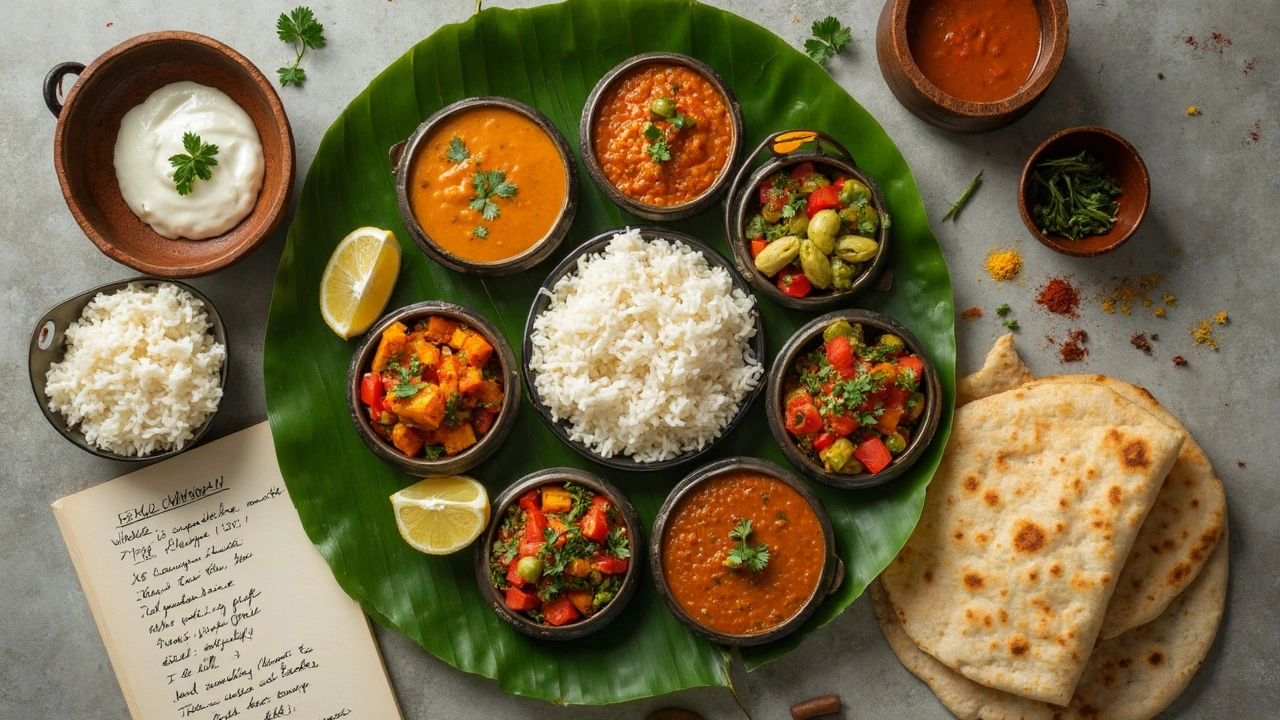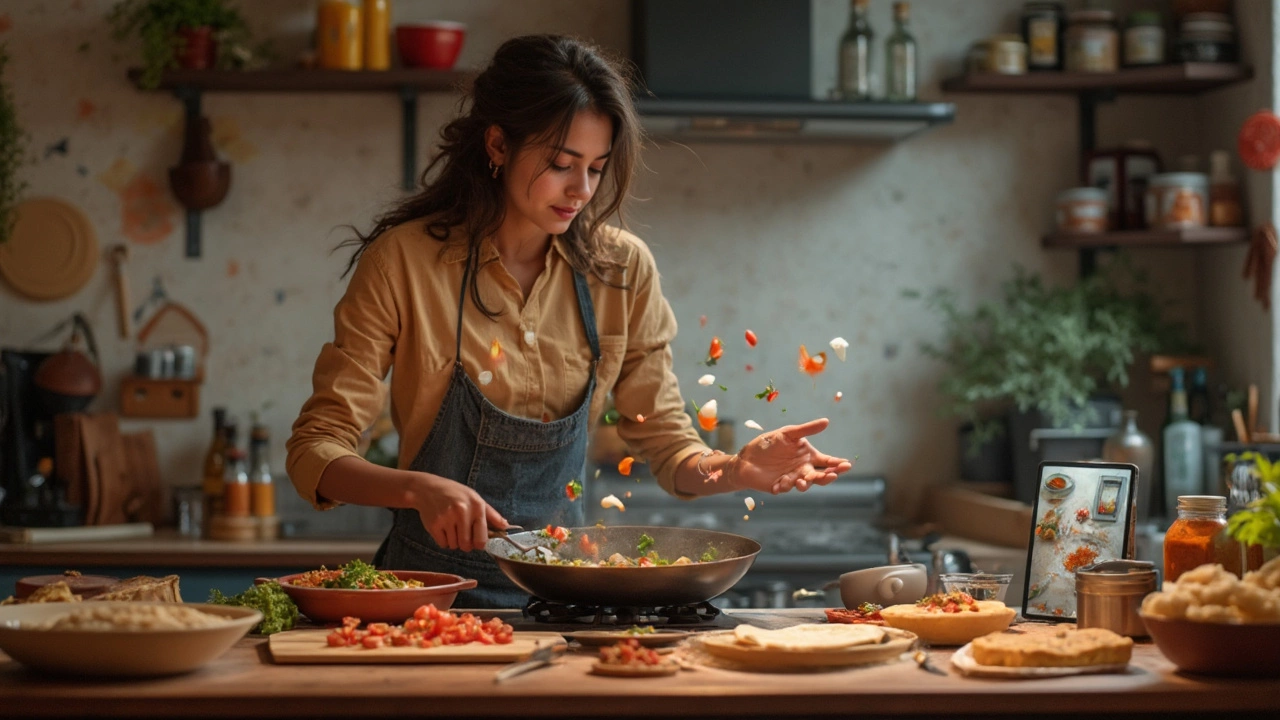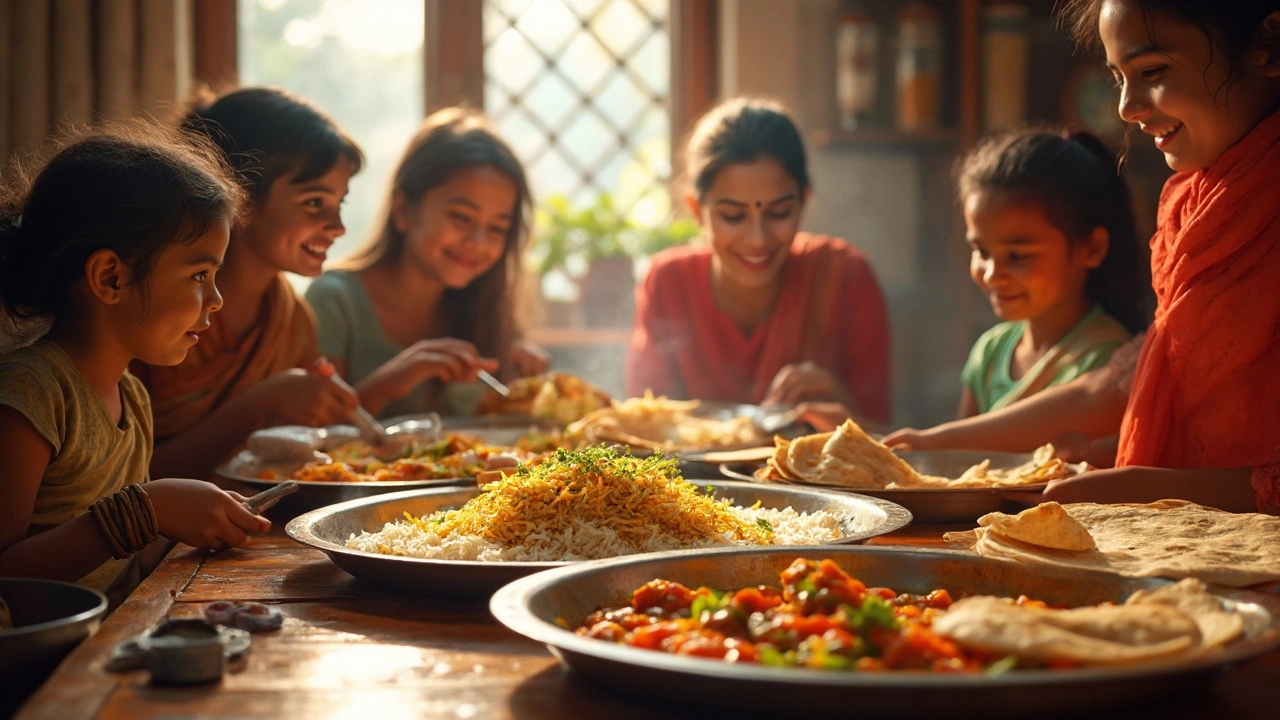If you peeked into kitchens across India right now, you’d see a familiar sight—simple meals built around rice or roti, plus dal, a veggie dish, maybe a little pickle. It’s not about fancy curries or restaurant-style spreads. Most homes stick to basics that are filling, affordable, and easy enough to make after a long day.
You might think every meal in India is an explosion of spices, tons of oil, or long-cooked meat curries. But here’s the truth: the heart of Indian everyday food is humble. The powerhouse combo is usually rice with dal (lentil stew), or roti with sabzi (a dry or lightly sauced vegetable). Everything else just depends on what’s in the fridge or who’s coming for dinner.
- The Everyday Indian Plate
- Why Rice and Dal Rule
- Vegetables, Breads, and Sides
- Regional Twists on the Classic Combo
- Quick Tips to Make It at Home
The Everyday Indian Plate
If you ask ten different Indian families what they cooked tonight, you’ll probably get similar answers—some combo of rice or roti, dal, a vegetable, and maybe a cooling raita or a bit of pickle. This really is what the average Indian home meal looks like, and it’s been this way for generations. It’s designed to give you protein, energy, and plenty of flavor without breaking the bank or your back.
The two big must-haves? Rice and dal in the southern and eastern parts of India; roti and sabzi in the north and west. Dal isn’t just a dish—it’s a lifeline. It’s cheap, filling, packs protein, and comes in tons of types (toor, masoor, moong, chana—you name it). Even a basic dal tadka—just lentils boiled and topped with sizzling, spiced oil—makes up the backbone of millions of Indian dinners.
The usual spread for a common Indian meal might have:
- Steamed basmati or short-grain rice, or fresh roti/chapati
- Simple dal (like yellow moong or toor)
- A dry or saucy vegetable stir-fry (sabzi), think aloo gobi or bhindi masala
- A spoon of pickle (achar) for a tangy kick
- Sometimes yogurt or salad on the side
It’s not about loading up the table with fancy food every day. Instead, everyday meals are practical but always satisfying. Families try to balance carbs (rice or roti), protein (dal), fiber (veggies), and probiotics (curd).
Here’s a quick look at stats that show just how common these foods are (based on the 2023 Indian Household Food Survey):
| Dish | % of Homes Serving Daily |
|---|---|
| Rice | 72% |
| Dal | 69% |
| Roti/Chapati | 59% |
| Vegetable Sabzi | 84% |
What’s great is you can put together a solid Indian plate with what you’ve got—no need for a trip to a special store. Swap in whatever lentil or vegetable you find. This flexibility is what keeps the common Indian meal at the heart of home cooking.
Why Rice and Dal Rule
Let’s get real—rice and dal are kind of like the PB&J of India. It’s the go-to meal in millions of homes because it’s cheap, fast, and loaded with benefits. While there are all sorts of dals (from classic yellow moong to creamy masoor), they all deliver protein at a price that beats meat—key for vegetarian families. Most days, this meal is plain, but comforting: hot rice, a scoop of dal poured on top, sometimes a splash of ghee if you’re feeling fancy.
The magic combo isn’t just about flavor. Rice and dal together give you a complete protein, which means you’re getting all the amino acids your body needs, even if you skip meat and eggs. If you look at food surveys, this combo shows up in nearly every state—from Tamil Nadu’s sambar rice to Bengal’s bhat-dal.
| State | Most Eaten Dal | Rice or Bread? |
|---|---|---|
| Punjab | Dal Tadka | Bread (Roti) but rice for dinner |
| West Bengal | Moong Dal | Rice (Bhat) |
| Karnataka | Toor Dal | Rice |
Why is this meal so popular? A bag of rice and a kilo of dal will feed a family for days, cost way less than meat, and takes maybe 30 minutes to cook if you use a pressure cooker. Plus, it’s healthy—no weird additives, easy to digest, and you control the salt and spice.
If you’re just getting into Indian recipes, mastering dal and rice is like passing level one. It’s worth learning, because once you can pull this off, you can upgrade with all sorts of toppings and side dishes later.

Vegetables, Breads, and Sides
It’s no exaggeration to say that vegetables, breads, and sides complete the common Indian meal. In India, you’ll find vegetables take center stage way more often than meat. Even in homes that eat non-veg, veggies still hit the table every day. A quick stir-fry (sabzi) of whatever’s in season—potato, cauliflower, okra, spinach, or green beans—paired with some spices, gets you a tasty, fast dish. People love potatoes (aloo), often cooked with cumin or tomatoes, and cauliflower (gobi) also pops up in a lot of lunchboxes.
Let’s talk breads. In the north, roti (unleavened flatbread) is a total staple. Sometimes you get paratha (stuffed or layered bread) or naan, but most homes stick with simple, whole-wheat roti. Down south, it’s more about rice, but breads like dosa (fermented rice-lentil crepes) play a big role too.
- Rice and Dal – Universal combo, but often served with a veggie side or salad.
- Roti and Sabzi – The go-to for quick lunches and dinners in many parts.
- Pickle and Chutney – Tiny but powerful, a spoonful on the side for crunch, heat, or tang.
- Curd/Yogurt – Calms the spices, cools things down; almost always in the fridge.
Curious what’s actually common? A 2023 survey across Indian metros found that 68% of home-cooked meals included at least two kinds of fresh vegetables, and more than half had some kind of dal, with roti or rice as the base.
| Item | Percentage of Indian homes (daily) |
|---|---|
| Roti/Chapati | 72% |
| Rice | 85% |
| Dal (Lentils) | 53% |
| Vegetable Sabzi | 68% |
| Pickle/Chutney | 55% |
| Curd/Yogurt | 47% |
So if you want to start cooking authentic Indian recipes at home, work on your basic roti, a simple veggie sabzi, and don’t forget a little pickle or yogurt on the side. You’ll already be on your way to eating like millions of Indian families.
Regional Twists on the Classic Combo
No matter where you go in India, the common Indian meal looks a little different from state to state. Each region has its own spin, based on climate, local crops, and family traditions.
In North India, wheat is king. People mostly eat roti or chapati with dal and a dry sabzi, maybe a little curd (yogurt). A typical lunch plate in Delhi or Punjab would have:
- Chapati (whole wheat flatbread)
- Yellow dal (often made from moong or toor dal)
- A dry veggie dish like aloo gobi (potato & cauliflower)
- Pickle and sometimes a salad of fresh onions and cucumber
Down South, you’ll spot rice almost every single meal. The usual suspects on a Tamil or Andhra table are:
- Steamed rice
- Sambar (a tangy lentil stew with veggies)
- Rasam (a thin, spicy soup for mixing with rice)
- A quick veggie stir fry (like beans poriyal)
Western India, especially Gujarat, is famous for its thali—a platter with small servings of many things, including sweet dal, shaak (veggie curry), rice, and thin rotlis. In Maharashtra, the staple is simple: rice, varan (a mild dal), and sabzi.
| Region | Staple Grain | Common Dal | Main Side |
|---|---|---|---|
| North | Wheat (roti) | Yellow dal | Dry sabzi |
| South | Rice | Sambar/rasam | Veg stir fry |
| West | Rice/rotli | Sweet dal | Shaak |
| East | Rice | Moong or masoor dal | Fish or mixed veg |
East India, especially Bengal, brings in fish and a love for mustard oil. The Indian thali here can mean rice, dal, a fish curry, and a simple veggie like aloo posto (potato with poppy seeds).
So, the main theme stays the same—grain and lentil, with a veggie. But the flavors get swapped based on geography. If you’re looking to experience the ‘real’ Indian home cooking, try a week of these regional combos. You’ll be surprised at how something as simple as dal and rice changes from one state to another.

Quick Tips to Make It at Home
Getting that classic common Indian meal vibe isn’t complicated. You really just need the core stuff you probably already have in your kitchen. Here’s the playbook for making a basic meal like you’d see in an Indian home:
- Pick your base: It’s usually rice or roti (also called chapati). If you’re pressed for time, rice cooks faster. Brown rice works fine, but for the real taste, white basmati is the go-to.
- Dal is your best friend: Red lentils (masoor dal) cook in about 20 minutes—super friendly for weeknights. Rinse well, simmer with turmeric, and finish with a spice tadka: heat oil, add cumin and garlic, sizzle, and pour over your dal.
- Veggie side: Just chop whatever’s in season or at the bottom of your fridge. Toss with a little oil, cumin, salt, and maybe a pinch of chili—done in 10-15 minutes.
- Pickle or yogurt for the win: Both take things up a notch. If you’ve got a jar of mango pickle or a cup of plain yogurt, you’re golden.
If you hate making a mess, cook your dal and rice together in one pot using the pot-in-pot method with a pressure cooker or Instant Pot. Saves crazy amounts of time and dishes. If you’re working with only a stovetop, a regular saucepan for rice and a second pot for dal will do the job too.
You’d be surprised, but a 2023 survey showed about 54% of Indian families in cities eat dal-rice or roti-sabzi for dinner five days a week. These numbers show it’s not just tradition—it’s what genuinely works for busy families.
| Meal Part | Typical Cooking Time |
|---|---|
| Rice (Basmati) | 15-20 min |
| Dal (Masoor or Moong) | 20-25 min |
| Simple Sabzi (Vegetable) | 10-15 min |
| Whole Wheat Roti | 2-3 min/piece |
Don’t sweat if you’re missing ingredients. Sub lentils for canned beans, or use tortillas instead of roti for a quick fix. The idea is to keep it tasty, simple, and true to that Indian home cooking feel.
